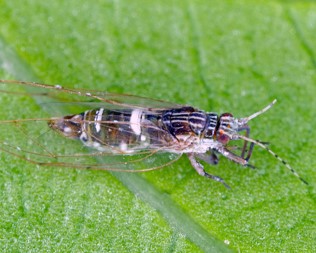A new insect pest is attacking tomatoes, potatoes and related crops in New Zealand gardens. The tomato/potato psyllid (also known as TPP) is from North America. It was first found in New Zealand in 2006, and is spreading throughout the country. The tomato/potato psyllid breeds mainly on plants in the Solanaceae (potato and tomato family), but can also attack some species of Convolvulaceae (kumara and bindweed family). Other host plants of the tomato/potato psyllid include Apple of Peru, capsicum, chilli, egg plant, kumara, poroporo, tamarillo and thornapple.
Why is the Psyllid a Problem?
Tomato/potato psyllid adults and nymphs cause damage to host plants through feeding on leaves and by transmitting a bacterial pathogen, Liberibacter, that lives in plants. The bacterium is believed to cause diseases such as ‘psyllid yellows’ in tomatoes and potatoes, and ‘zebra chip’ symptoms in potato tubers. These diseases can drastically reduce the quality and yield of your crop.
What does the Psyllid look like?
The adult tomato/potato psyllid is about the size of an adult aphid but looks like a tiny cicada under magnification. The female lays yellow eggs that are attached by stalks to plant leaves, usually to the leaf edges. Psyllid nymphs hatch from these eggs and after five moults become adults. The nymphs are flat scale-like insects which are mostly inactive but move when disturbed. Nymphs and adults feed by sucking plant juices, which is how they are thought to spread Liberibacter.

Nymphs and adults secrete plant sap as white granules called ‘psyllid sugars’ which can be seen on the leaves. In humid conditions and where there are large numbers of psyllids, black sooty mould fungi can grow on the sugars. Dense sooty mould on leaves may reduce photosynthesis, but this is rarely a problem on outdoor plants as the psyllid sugars are usually removed by wind and rain.
How will the Psyllid effect my plants?
On tomato the symptoms of psyllid yellows are the yellowing and stunting of the growing tip and a cupping or curling of the leaves. Many flowers may fall off the trusses of infected plants and fruit may be small and mis-shapen.
Symptoms of psyllid yellows on potato plants. On potato, psyllid yellows disease causes a stunting and yellowing of the growing tip, and the edges of the curled leaves often have a pink blush. The stem may have swollen nodes and show a browning of the vascular tissue. After a while, infected potatoes develop a scorched appearance and plants collapse prematurely. Potato plants that are infected at an early stage develop numerous small tubers. When potato tubers infected with Liberibacter are fried they show dark zebra chip stripes, which may also be seen in fresh tubers. When infected tubers are boiled they are mushy with an earthy taste.
How do I manage Psyllid
Control without insecticide:
• Don’t bring infested plants into your garden or greenhouse. Check the plants you purchase are free of psyllids and other pests.
• Between crops, especially in winter, remove all psyllid host plants especially volunteer potato plants. If psyllids are present on tamarillo trees during the winter, remove and bag infested leaves.
• Avoid keeping any psyllid-infested plants in greenhouses over the winter.
• Encourage natural enemies. Several predators including some kinds of ladybirds and lacewings will feed on psyllids.
• White and silver reflective ground coverings are reported to reduce psyllid infestations.
• Pull out any plants showing symptoms of psyllid yellows and dispose of the plant material in sealed rubbish bags.
Control with insecticides:
Yates Mavrik is now the registered control of this pest.
To increase the effectiveness of insecticides gardeners should:
- Inspect plants regularly for the presence of psyllids, so that treatments can be applied while number are low.
- Remove and bag as many leaves infested with psyllid eggs, nymphs, or adults as possible before applying an insecticide. When applying insecticide, concentrate on the underside of the leaves, where most of the psyllid adults and nymphs live. Depending on the insecticide used, more than one application may be required (7-14 days apart) to kill all the nymphs (most insecticides will not kill eggs).
- During the growing season, use insecticides from more than one group, to avoid the insects becoming resistant to an insecticide group.
- It is important to control psyllids on young plants as they are most vulnerable to psyllid yellows. Older plants are still vulnerable to infection by the bacterium, but any fruit that is set will still be harvestable.
Follow label instructions carefully.
FURTHER INFORMATION
Land Care Research and Plant & Food Research host reliable studies.
PJ Workman – Plant & Food Research
Private Bag 92169
Auckland 1142, New Zealand
tel: +64-9-845 9000
fax: +64-9-925 7001
workmanp@crop.cri.nz
